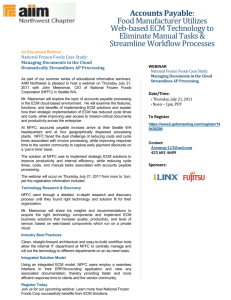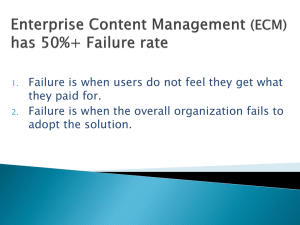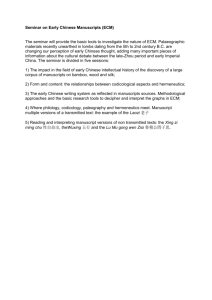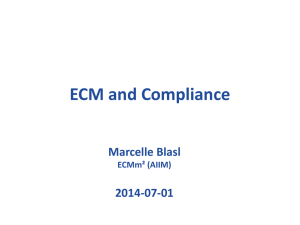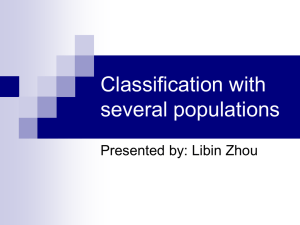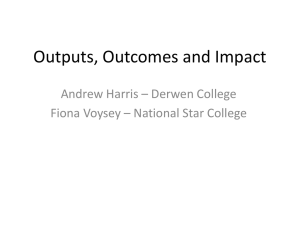Extracellular Matrices – The Future of Regenerative Medicine
advertisement
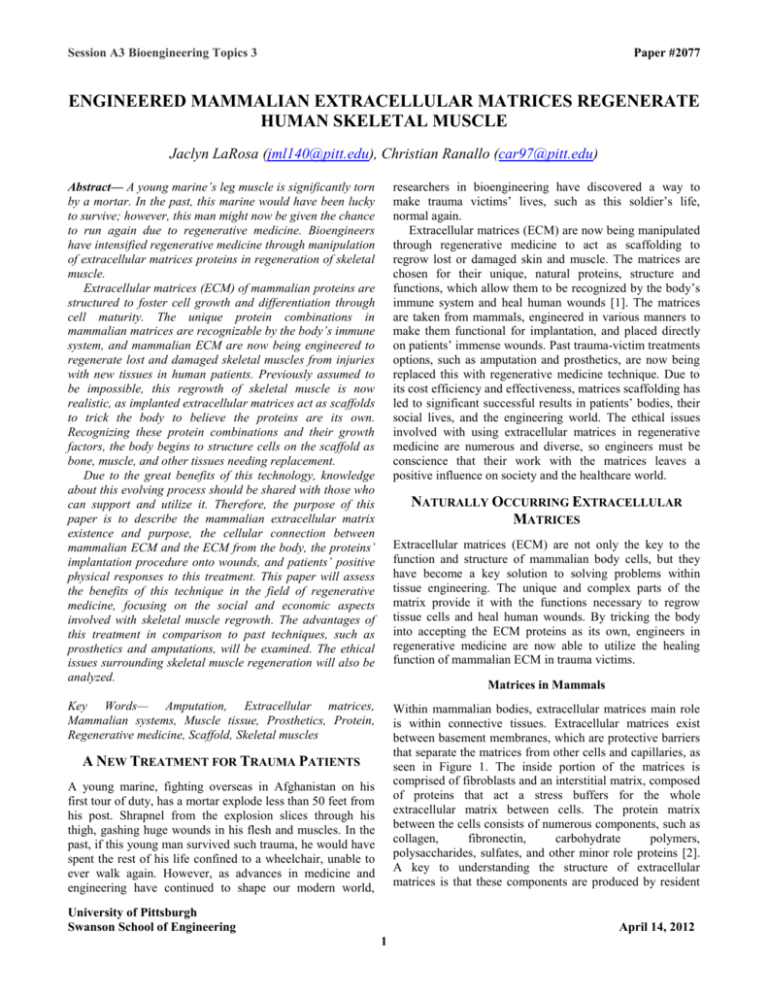
Session A3 Bioengineering Topics 3 Paper #2077 ENGINEERED MAMMALIAN EXTRACELLULAR MATRICES REGENERATE HUMAN SKELETAL MUSCLE Jaclyn LaRosa (jml140@pitt.edu), Christian Ranallo (car97@pitt.edu) Abstract— A young marine’s leg muscle is significantly torn by a mortar. In the past, this marine would have been lucky to survive; however, this man might now be given the chance to run again due to regenerative medicine. Bioengineers have intensified regenerative medicine through manipulation of extracellular matrices proteins in regeneration of skeletal muscle. Extracellular matrices (ECM) of mammalian proteins are structured to foster cell growth and differentiation through cell maturity. The unique protein combinations in mammalian matrices are recognizable by the body’s immune system, and mammalian ECM are now being engineered to regenerate lost and damaged skeletal muscles from injuries with new tissues in human patients. Previously assumed to be impossible, this regrowth of skeletal muscle is now realistic, as implanted extracellular matrices act as scaffolds to trick the body to believe the proteins are its own. Recognizing these protein combinations and their growth factors, the body begins to structure cells on the scaffold as bone, muscle, and other tissues needing replacement. Due to the great benefits of this technology, knowledge about this evolving process should be shared with those who can support and utilize it. Therefore, the purpose of this paper is to describe the mammalian extracellular matrix existence and purpose, the cellular connection between mammalian ECM and the ECM from the body, the proteins’ implantation procedure onto wounds, and patients’ positive physical responses to this treatment. This paper will assess the benefits of this technique in the field of regenerative medicine, focusing on the social and economic aspects involved with skeletal muscle regrowth. The advantages of this treatment in comparison to past techniques, such as prosthetics and amputations, will be examined. The ethical issues surrounding skeletal muscle regeneration will also be analyzed. researchers in bioengineering have discovered a way to make trauma victims’ lives, such as this soldier’s life, normal again. Extracellular matrices (ECM) are now being manipulated through regenerative medicine to act as scaffolding to regrow lost or damaged skin and muscle. The matrices are chosen for their unique, natural proteins, structure and functions, which allow them to be recognized by the body’s immune system and heal human wounds [1]. The matrices are taken from mammals, engineered in various manners to make them functional for implantation, and placed directly on patients’ immense wounds. Past trauma-victim treatments options, such as amputation and prosthetics, are now being replaced this with regenerative medicine technique. Due to its cost efficiency and effectiveness, matrices scaffolding has led to significant successful results in patients’ bodies, their social lives, and the engineering world. The ethical issues involved with using extracellular matrices in regenerative medicine are numerous and diverse, so engineers must be conscience that their work with the matrices leaves a positive influence on society and the healthcare world. Key Words— Amputation, Extracellular matrices, Mammalian systems, Muscle tissue, Prosthetics, Protein, Regenerative medicine, Scaffold, Skeletal muscles Within mammalian bodies, extracellular matrices main role is within connective tissues. Extracellular matrices exist between basement membranes, which are protective barriers that separate the matrices from other cells and capillaries, as seen in Figure 1. The inside portion of the matrices is comprised of fibroblasts and an interstitial matrix, composed of proteins that act a stress buffers for the whole extracellular matrix between cells. The protein matrix between the cells consists of numerous components, such as collagen, fibronectin, carbohydrate polymers, polysaccharides, sulfates, and other minor role proteins [2]. A key to understanding the structure of extracellular matrices is that these components are produced by resident NATURALLY OCCURRING EXTRACELLULAR MATRICES Extracellular matrices (ECM) are not only the key to the function and structure of mammalian body cells, but they have become a key solution to solving problems within tissue engineering. The unique and complex parts of the matrix provide it with the functions necessary to regrow tissue cells and heal human wounds. By tricking the body into accepting the ECM proteins as its own, engineers in regenerative medicine are now able to utilize the healing function of mammalian ECM in trauma victims. Matrices in Mammals A NEW TREATMENT FOR TRAUMA PATIENTS A young marine, fighting overseas in Afghanistan on his first tour of duty, has a mortar explode less than 50 feet from his post. Shrapnel from the explosion slices through his thigh, gashing huge wounds in his flesh and muscles. In the past, if this young man survived such trauma, he would have spent the rest of his life confined to a wheelchair, unable to ever walk again. However, as advances in medicine and engineering have continued to shape our modern world, University of Pittsburgh Swanson School of Engineering April 14, 2012 1 Jaclyn LaRosa Christian Ranallo cells, secreted through the basement membranes, and combined with the existing matrices. This process allows the ECM to reproduce itself, as well as regrow old or damaged cells surrounding it. The main roles of the ECM derive directly from this production process and the components conducting it. new cells, their various components allow them to heal small wounds easily and quickly. Collagen and fibronectin act as markers, signaling where the wound is and providing strength during the new cells’ remodeling [2]. When the body is faced with a serious, traumatic injury, outside healing assistance is often needed for the injured part of the body to regain function. This is due to the fact that injured ECM is often corrupted and becomes unresponsive to more cells growth factor signals. Regenerative medicine is now using extracellular matrices to ‘trick’ the body into healing faster when the bodies out matrices cannot work fast enough to heal the wound. All cells contain genetic material (DNA), which is composed of different nucleic acids, expressed in combinations to make unique proteins codes. These protein codes are what denote a cell’s function and structure, but all combinations of proteins are created using the same nucleic acids. For this reason, extracellular matrices from outside the body, even from mammals, can be used on human wounds, and the body’s immune system will not reject the matrices as an invader or infection to the body. When the body reads the codes of the ECM proteins placed on the wound, it is tricked to believe the implanted matrices are its own healthy and functional ECM. This allows the new, mammalian ECM to act as a scaffold on which the body believes it should grow new cells, including muscle, skin, bone and blood vessel cells. Even though the trauma is greater in the larger healing processes, it takes proportionally the same amount of time to complete healing with the addition of mammalian matrices as it would for the body’s own ECM to heal a smaller wound. The protein recognition and scaffolding process is what allows the ECM to play such a major role in regenerative medicine. Trauma victims with chronic wounds have long suffered life-long disabilities because of their disabled extracellular matrices that could no longer heal wounds, in addition to the lack of ECM healing application in science [2]. Now, through this complex yet efficient process of manipulating outside ECM as scaffolding, these types of patients can now lead normal lives. FIGURE 1 ILLUSTRATION DEPICTING EXTRACELLULAR MATRIX COMPONENTS IN COMPARISON TO CONNECTIVE TISSUE [3] The functions of the components of the ECM are what truly play a huge role in the growth of cells by the ECM. Composing 90% of the ECM, collagen provides structural support to the resident cells [1]. Collagens are triple, twisted helixes, made of alpha peptides, which enable them to have immense strength [1]. Large bundles of different types of collagen then form various-functioning, mature tissues in the ECM. Fibronectin is the next key component within the ECM, for it connects the collagen fibers to cells and the matrix walls, allowing the cells to move through the ECM [1]. This allows the matrix skeleton to move easily, especially to affected areas in order to heal wounds. Fiberonectin also plays a key role in the regrowth of skeletal muscle cells through their adhesion. Skeletal muscle differentiates between transcription markers during its regenerative period, so it prefers attaching to the binding area sequences on fiberonectin in order to get the best growth response [4]. Next, elastin is especially necessary in ECM during the healing process, for it is useful for skin and blood vessel’s proper function. Cross-linked protein strands give elastin the ability to stretch when needed and return to its original state Controlling the growth of certain cells within the body, the matrix also has the role of regulating intercellular communication and mediating growth factor activation. The most important role the extracellular matrices possess that pertains to regenerative medicine is their ability to heal wounds. MAKING IT HAPPEN In order for the young, injured marine to walk again, his treatment option must be perfected, as any mistakes could lead to additional pain and problems. The process of regeneration of human skeletal muscle using mammalian extracellular matrices (ECM) begins with deriving the ECM from the tissues of laboratory mammals. Porcine and bovine tissues are the two most common sources of usable ECM, although human tissue can be used, as well, depending on the circumstance. The ECM can be taken from a variety of body tissues, including heart valves, blood vessels, skin, nerves, skeletal muscle, tendons, ligaments, liver, and other organs [5]. The origin of the ECM is solely dependent on its purpose within the treatment; for example, skeletal muscle Connection to Regenerative Medicine When the body becomes wounded, the ECM components respond in four different phases: hemostasis, inflammation, proliferation, and remodeling, each directed by different growth factors [2]. Because ECM control the production of 2 Jaclyn LaRosa Christian Ranallo ECM is used primarily in the regrowth of large muscle tissues. A third common preparation for ECM involves dehydrating the ECM in sheets and turning the sheets into a fine powder intended for injection. Powder form dehydrated matrices are especially useful for minimally invasive techniques, such as scaffolding needed in the urinary tract or other similarly small areas [5]. A final method of preparation for ECM is producing it in a liquid or gel-like form. The liquid form often works better than the powder form during insertion, as it is easier to deliver to a specific site than a suspension of powder particles [5]. Figure 3 clearly demonstrates the difference in consistency between the sheet form and powder form of ECM, which are specific to their individual roles. In the regeneration of skeletal muscle, the most useful and commonly operated preparation of ECM is when it is in sheet form. TABLE I Preparing the Matrices After the ECM had been extracted from the mammal, the next step in the procedure is the decellularization of the mammalian ECM. This process takes places to ensure that the ECM is totally sterile, as to avoid being rejected by the body’s immune system and avoid any bacteria being added into the body [5]. In this process, all of the remaining cell membranes, including living components of tissues or organs and any other non-sterile particles that may be present, are cleansed from the ECM scaffold. The protein shell of the ECM remaining for implantation is the only component left then. Following decellularization, the remaining tissue shell must be rehydrated in order to maintain the original tissue architecture [5]. Rehydration must occur in order to prevent the collagen fibers from collapsing and the ECM molecules from bonding within the tissues. The ECM may also need to be dehydrated depending on what the method of usage will be during the actual implantation procedure. There are several specific ways that the extracellular matrices can be prepared for their use in human muscle regeneration. One of the most commonly used mechanisms is the sheet form. Dehydrated ECM scaffolds are often compiled into a thin sheet of coarse protein material, anywhere from a few millimeters to nearly a foot in length if necessary [5]. These sheets function perfectly to cover large injuries, such as battle wounds or other large amounts of damage to body muscle. Another common preparation for the dehydrated extracellular matrices is vacuum pressing, which prepares three dimensional models of scaffolds. These three dimensional models are most often used for the regrowth of organs, mainly tubular ones, such as the esophagus or other organs within the gastro-intestinal system, as shown in Figure 2 [5]. EVALUATION OF THE FOUR MAJOR PREPARATIONS OF EXTRACELLULAR MATRICES AND THEIR IMPLANTATION LOCATIONS ECM Preparations Dehydrated Sheet Major Advantages -Large surface area -Can regrow large amounts of muscle 3-D Vacuum Pressed Model -Pressed to fit needed space -Used to mimic organ size and shape -Minimally invasive -Large surface area for small amount -Easy insertion -Delivers well to specific site Powdered ECM Liquid/ Gel Form Locations of Usage -Large wounds -Soft muscle tissue Ex: quadriceps -Organ or valve replacements Ex: larynx or esophagus -Small exposed surfaces Ex: fingers or toes -Small, condensed areas Ex: urinary tract Implanting the Matrices The most common and traumatic injuries inflicted on human skeletal muscles occur to soldiers, who are fighting to defend their country. In fact, the majority of physical injuries that are inflicted on our troops are wounds to soft muscle tissue. These wounds are often extreme, either being losses of large amounts of muscle, or deep lacerations into their muscle tissue [4]. The only significantly beneficial method to treat these two types of wounds is the use of extracellular matrices to regrow the missing tissue. Therefore with these large wounds, the most beneficial method of preparing the ECM is in dehydrated sheet form, shown in Figure 3, in order to cover the most surface area within the injured tissue. The prepared ECM is either sewn onto the remaining tissue using organic thread that naturally disintegrates into the body with no harmful effects, or the matrix is inserted into the body through an incision created in the skin using microtechnology [5]. FIGURE 2 VARIOUS THREE-DIMENSIONAL MODELS OF DEHYDRATED EXTRACELLULAR MATRICES SCAFFOLDS. THEIR APPLICATION LOCATIONS (FROM LEFT TO RIGHT): ESOPHAGUS, [6] 3 Jaclyn LaRosa Christian Ranallo ECM, eventually regenerating the lost muscle tissue. Through this complex process and the variety of resulting benefits, trauma patients are left with the hope that they will efficiently heal and their lives will continue as normal. BENEFITING FROM THE RESULTS The magnificence of the process of implanting extracellular matrices (ECM) as scaffolding on wounds does not stop with the proteins’ integration into the body. The benefits from the results of this procedure are what have truly brought it into the forefront of regenerative medicine. Compared to past treatment options for trauma victims, such as amputation and prosthetics, ECM scaffolding has proved to be a more effective and efficient process of healing. The physical benefits lead to social benefits in patients’ lives as well, as patients can integrate themselves back into society at a quicker and smoother pace. Economically, ECM scaffolding will make a huge positive influence not only in patients’ lives, but the healthcare and bioengineering worlds. Despite the extensive advantages to using extracellular matrices in regenerative medicine, there are also a few drawbacks to the process, but these aspects have not slowed down the work or use of ECM. FIGURE 3 COMPARISON BETWEEN THE SHEET FORM AND THE POWDERED FORM OF A DEHYDRATED ECM SCAFFOLDING PRODUCT. THE CHOSEN PRODUCT DEPENDS ON ITS APPLICATION LOCATION ON THE BODY. [7] Once the dehydrated matrices have been inserted onto the wound site, the body’s natural reactions begin to take over. Due to the richness of growth factors and the abundant bifunctional molecules such as fibronectin and collagen within the ECM, many biological activities that were previously lost in the destroyed tissue begin again within the wound site [4]. Cell growth is once again stimulated, as well as angiogenesis, cell proliferation, cell migration, and cell differentiation [5]. These activities are the basis for new cell life, and as the number of new cells increases, new living tissue begins to appear. The new tissue that is regenerated in the wound is produced so that the structures of the tissue cells are exactly the same to that of the original tissue, prior to the injury. This process occurs because the new matrices act as a natural scaffold for the production of this new tissue structure, for the proteins that remain in the dehydrated ECM are natural building blocks on which the production of new cells occurs [4]. Growth factors in the ECM continue to stimulate cell growth until the tissue has been regenerated in its pre-injury form and size, and then the body notifies the cells to stop growing. Another large problem that the extracellular matrices are able to overcome due to their organic nature is the body’s immune system. When a major wound occurs, such as a large laceration or the loss of a digit such as a finger or toe, the normal response for the human body is to trigger an immediate death to all cells that are now in contact with the outside world [8]. This self-sacrifice occurs in order to prevent bacteria, viruses and other unwanted pests from entering the body. The cells then die, effectively quarantining off the injured area. While this does protect the living cells nearby and the rest of the body, it takes away any chance of the injured tissues ever regenerating to their original, functioning structures. When the ECM is added to the wound site, the body does not reject it, as the proteins within the dehydrated matrices are recognized to be similar to those of tissues cells within the body. The protein codes of the ECM are so similar, that the proteins within the body read the ECM as naked proteins, lacking companion cells. Because the body believes this information about the new cells, it begins to produce new, fresh cells on the protein scaffolding of the Physical Results When an amputation occurs on a patient’s leg at the knee, the skin of the patient is sewn shut to replicate a continuation of leg’s skin. This process may enable a prosthetic leg to attach to what is left of the patient’s leg, but the internal effects of the patient’s leg are not as pleasant. Nerve and bone pain and poor circulation often reoccur throughout the lives of amputee patients. These negative effects are the results of the dead-ended nerves and scar tissue that form when a section of a major part of the leg, or any limb, is suddenly removed [9]. Over 57% of amputee victims using prosthetics limbs say they are not satisfied with their prosthetics device, and that they are forced to deal with the issue of reoccurring pain at the site of their amputation [10]. On the other hand, ECM scaffolding prevents this trauma or pain from reoccurring in victim’s lives. As a patient heals using ECM protein power on their wound, the implanted extracellular matrices regrow cells to replace the exact cells that were removed. This process beneficially includes restoring the exact function and structure of the previous cells in the new cells, preventing a lasting, internal trauma inside the body. On average after 12 weeks of treatment, 92% of patients are fully or partially healed after the use of ECM scaffolding treatment on major leg wounds [9]. Figure 4 demonstrates this exact healing and efficient replication of muscle tissue and skin through the use of ECM scaffolding. 4 Jaclyn LaRosa Christian Ranallo past trauma [10]. This positive outlook then reinforces the benefits of regenerative medicine, leading to economic boosts in bioengineering’s status through funding. Economic Advancements Treatment price and funding are always an issue in the healthcare world, especially for complex, yet necessary procedures. In the long-run, ECM scaffolding would be a much cheaper and efficient choice versus having an amputation and purchasing prosthetic devices. Muscle regeneration requires a one-time payment for the ECM scaffolding procedure, and the patients usually require no other medical treatment in their life once the wound is fully healed by the ECM. Even though trauma patients must usually apply this powder to their wounds at least once a day for several months, the manufacturing cost of the powder is minimal compared to the amputation charges [13]. Amputation costs include: the surgery costs of tens of thousands of dollars, hundreds of dollars in pain medication, and approximately a $10,000 payment every 4 years for a new prosthetic limb [13]. This excessive total cost can place tremendous and continuous financial strain on families with amputee patients. The potential decreased demand for prosthetics in the healthcare world by preserving limbs with ECM scaffolding is also an economical benefit of this treatment. A small move in funding and energy from designing new prosthetic devices to regenerative medicine research would open up the opportunities for more extensive cellular disease research and ECM scaffolding in the bioengineering field. Once the process of extracting and using ECM has been further researched, the cost of manufacturing the ECM protein powder will also decrease. The more ECM research is funded in the bioengineering field, the more efficiently and effectively cellular research in other fields of engineering will occur, as they will be able to base their research off concepts in regenerative medicine. Although, the intense research in bioengineering and other research fields does not come without precise concern of the ethical issues involved in science and society. FIGURE 4 KNEE AND THIGH OF ARMY CAPTAIN HEALED AND REGROWN USING ECM SCAFFOLDING [11] A few drawbacks do occur from using extracellular matrices to heal wounds; the first being the initial length of time to heal the wound. Although amputation usually leads to future pain at the sight of the old wound, it also results in immediate closure of the wound. Using ECM powder to heal trauma wounds can take a week or so before the initial would is closed over. Also, there is potential for the body’s immune system to respond to the new ECM with rejection [12]. Due to the same nucleic acids composing the old ECM proteins and new, implanted ECM proteins, the body’s rejection response is rare. If this negative response did occur, it would be caused by mutations in the DNA composing the implanted proteins, which the body would then not recognize as its own [12]. Despite these minor issues involved with the use of ECM scaffolding, the physical benefits surrounding ECM use outweigh the drawbacks, especially as they lead to many social benefits in patients’ lives. Social Benefits Returning to a normal life is one of the main goals of manipulating ECM as a healing method for trauma patients. When a patient is seriously wounded, such as a soldier’s leg being shredded by shrapnel, his world stops and everything he was involved with comes to a halt. The trauma victim’s now focuses his remaining energy into regaining his life, hoping to return to the place and time it was before his injury. Because the new ECM implanted in trauma victims enables skin, bone and skeletal muscle to regrow with the same structure and function that it previous had, patients can regain mobility and operation in their injured limbs in only a few months [9]. In relation to the immense trauma the patients have endured, this short amount of healing time allows patients the ability to continue their lives without making alternative plans for their future. Also, the regrowth of skin and muscle due to ECM scaffolding provides patients with the feeling of social acceptance after their injury versus amputees and patients with prosthetics, who are often seen differently in social places. Therefore, the morale and future outlooks often increase dramatically in a shorter period of time for ECM scaffolding patients versus amputees and prosthetic patients, who live with a daily reminder of their ETHICAL CONNECTIONS People often believe that bioengineering is the most ethically controversial field of engineering, as it is the only field of engineering that deals directly with the human body. The National Society of Professional Engineers (NSPE) created an ethical code that sets the standards for ethical behavior for all engineers, and the work done surrounding extracellular matrices (ECM) must follow this code, as well [14]. The process of regenerating human skeletal muscle through the usage of ECM certainly faces several ethical issues, as it does involve several topics which are considered to be controversial in the world of ethics. However, this scaffolding technique is proven to be ethically sound, as it 5 Jaclyn LaRosa Christian Ranallo does not conflict with the moral standards of society or with the NSPE code of ethics. Animal Involvement A final criticism that commonly follows areas of research is the use of animals and their treatment in the research. Many people believe the use of animals as test subjects for research is immoral and even against the law. People for the Ethical Treatment of Animals (PETA) and other animal rights activist groups are always attempting to rile the public to protest the use of animals in laboratory testing, yet the truth is that these animals are often treated better than many others, such as animals used in media fields [16]. The animals that are used in this research are never forced to bear large amounts of pain or undergo tests in cruel conditions as animals used in other fields of research often are subjected to. The swine, cattle, and other mammals whose parts are a crucial to this procedure are normally bred for food and are treated with less care than those bred for labs are. Therefore, much of the mammal tissue used in the procedures comes from the cadavers of animals killed for other purposes, such as for food. This method is possible because the scaffolding procedure only requires the ECM of the mammals, which can be obtained from the leftover organs of mammals cadavers [5]. Preventing the waste of life, this process is the most beneficial way to recycle the leftovers of animals used in the food industries. In addition, there are no actual laws restricting the use of certain animals in research. The Animal Welfare Act (AWA) is designed to set standards for the use of animals in research, yet it does have specifications covering all animals [17]. These unprotected animals include: rats, mice, birds, reptiles, amphibians, and livestock, such as swine and cattle that contain the needed ECM [18]. Engineers do provide this humane treatment to animals, though, because they know the benefits and the intensity of the complex research they are completing, and researchers do not want their valuable, hard work to be turned away by society. Defying Divine Powers? One focal point in the ethical battle involving the use of ECM in muscle tissue regeneration is the misguided belief that the scaffolding procedure is attempting to achieve a level of progress that humanity should not be able to reach. As human beings, we are conceived naturally, and we receive the parts and body structure necessary to survive, without extras. Therefore, when a patient is in need of an organ, the only source for a replacement would be from another human through a transplant. With new bioengineering technology, the growth and reformation of organs has become a reality, and many people view this as immoral, a threshold that we as human beings should not be able to cross. However, this is not true, as researchers are not creating life out of nothing, or unnatural material; they are simply taking living organic material and culturing it into a product that is needed to heal the patient. In the regeneration of skeletal muscle using ECM, entire organs are not being produced, and no new life is being created out of nothing. The process simply involves implanting organic material from other mammals into the body to help the body regenerate muscle tissue that was already in existence prior to the injury that the victim endured. This procedure does not break any moral laws, and it certainly cannot be viewed as unnaturally affecting life or extending the medical powers of society beyond human capacity. Those that find the replication of nature to be unethical can simply look around, as our society has been replicating nature for thousands of years now. The difference now is that this replication technology has a scientific purpose, as it is used to heal and save many lives. Natural vs. Unnatural Another ethical complaint that groups often fire against many bioengineering processes is the involvement of implanting material into the body that is not naturally found existing there. Realistically, this argument has no factual basis, as any sort of artificial organ, prosthetic limb, or transplant is adding something to the body that is not normally found on or inside the body. In fact, almost the exact same extracellular matrices compared to the new implanted ones are naturally found throughout the human body, as ECM is a vital component of the every mammalian body. In the treatments to regrow skeletal muscle, the only difference between the implanted ECM and the natural ECM found within the patient is the origin of the matrices [15]. The implanted matrices are constructed of the same collagen, fibronectin, nucleic acid protein codes and other crucial components as the human ECM [5]. Although they come from different sources, the implanted mammalian extracellular matrices are essentially the same as the ECM found within the body of the patient. EXTRACELLULAR MATRICES – THE FUTURE OF REGENERATIVE MEDICINE Extracellular matrices (ECM) are more than supportive, connective tissue in mammalian bodies; they represent a future of new, directed research and saved lives, especially to engineers in regenerative medicine. The unique composition of ECM, mainly including collagen, fiberonectin and elastin, allow them to play the role of provider, supporter and director of their neighboring cells’ function throughout the body. ECM healing function is truly their most crucial purpose, specifically to trauma victims; for they are used to directly heal wounds by regrowing cells the body’s damaged ECM would not be able to create. Through a complex, yet refined process, the ECM is engineered to be directly applied to patients’ wounds, where the body recognizes the protein codes of the new ECM and incorporates its structure as part of the body. 6 Jaclyn LaRosa Christian Ranallo [10] Timothy R. Dillingham, Liliana E. Pezzin, Ellen J. MacKenzie, Andrew R. Burgess. (2001, August). “Use and Satisfaction with Prosthetic Devices Among Persons with Trauma-Related Amputations: A Long-Term Outcome Study.” American Journal of Physical Medicine & Rehabilitation. [Online]. Available: http://ovidsp.tx.ovid.com/?QS2=434f4e1a73d37e8ce55 [11] Brian Gardner. (2012) “Regenerative Medicine Makes Advances In Pittsburgh.” Target Health Global. [Online]. Available: http://blog.targethealth.com/?m=20100616 [12] Gerhard Feil, Lisa Daum, Bastian Amend, Sabine Maurer, Markus Renninger, Martin Vaegler, Jörg Seibold, Arnulf Stenzl, Karl-Dietrich Sievert. (2010, December 15). “From tissue engineering to regenerative medicine in urology — The potential and the pitfalls.” Advanced Drug Delivery Reviews Journal, Volume: 63, Issue 4–5. [Online]. Available: http://www.sciencedirect.com/science/article/pii/S0169409X10002905 [13] (2011, May 19). “Prosthetic Legs.” SciPolicy: Online Science Journal. [Online]. Available: http://www.scipolicy.net/prosthetic-legs/ [14] (2012). “NSPE Code of Ethics for Engineers.” National Society of Professional Engineers. [Online]. Available: http://www.nspe.org/Ethics/CodeofEthics/index.html [15] Drew Kuraitis, Céline Giordano, Marc Ruel, Antonio Musarò, Erik J. Suuronen. (2011, October 19). “Exploiting extracellular matrix-stem cell interactions: A review of natural materials for therapeutic muscle regeneration.” Elsevier Biomaterials Journal, Volume 33, Issue 2. [Online]. Available: http://www.sciencedirect.com/science/article/pii/S0142961211011707 [16] (2012). “The Issues.” People for the Ethical Treatment of Animals. [Online]. Available: http://www.peta.org/ [17] Richard L. Crawford. (2012, February). “Animal Welfare Act Quick Reference Guides.” United States Department of Agriculture. [Online]. Available: http://www.nal.usda.gov/awic/pubs/Legislat/awabrief.shtml [18] (2012, February). “Public Law 89-544 Act of August 24, 1966.” United States Department of Agriculture. [Online]. Available: http://awic.nal.usda.gov/public-law-89-544-act-august-24-1966 Benefits of this treatment option outweigh the benefits of older procedures, such as amputation and prosthetic use, for the use of ECM scaffolding is less painful, cheaper, quicker, and more socially inclined when healing trauma wounds. Many ethical issues are also present when working in regenerative medicine, especially with ECM. Bioengineers must be conscious to sensitive subject matter, such as surpassing the boundaries of human ability, placing unnatural material in the body, and treating animals humanely, when designing this sophisticated medical procedure. The future of regenerative medicine, the field of bioengineering, the healthcare world, society, and the lives of many trauma victims are all directly affected by the research surrounding the use of ECM as skeletal muscles scaffolding. The research and knowledge of ECM provides other branches of bioengineering with a new, cellular basis for their research. This foundation will increase the rate of creation of other medical procedures and the healthcare world’s plans concerning promising fields of developments. Extracellular matrices scaffolding is truly emerging as the most beneficial way to heal trauma wounds; and this process deserves a significant amount of attention as momentous benefits for all part of society derive from its outstanding results. REFERENCES [1] H. Lodish, A. Berk, S. Zipursky. (2000). “Noncollagen Components of the Extracellular Matrix.” U.S. National Library of Medicine. [Online]. Available: http://www.ncbi.nlm.nih.gov/books/NBK21706/ [2] G. Davin Haraway. (2006). “The Extracellular Matrix in Wound Healing.” HealthPoint. [Online]. Available: http://www.owm.com/files/docs/Healthpoint_July.pdf [3] (2004). ”Extracellular Matrix.” eNotes Science. [Online]. Available: http://www.enotes.com/topic/Extracellular_matrix. [4] Edward K. Merritt, M.S., David W. Hammers, M.S., Matthew Tierney, B.S., Laura J. Suggs, Ph.D., Thomas J. Walters, Ph.D., and Roger P. Farrar, Ph.D. (2009, November 19). “Functional Assessment of Skeletal Muscle Regeneration Utilizing Homologous Extracellular Matrix as Scaffolding.” Mary Ann Liebert Publishers, Volume: 16 Issue 4. [Online]. Available: http://online.liebertpub.com/doi/full/10.1089/ten.tea.2009.0226 [5] Stephen F. Badylak, Donald O. Freytes, Thomas W. Gilbert. (2008, June 23). “Extracellular matrix as a biological scaffold material: Structure and function.” Acta Biomaterialia, Volume: 5, Issue 1. [Online]. Available: http://www.sciencedirect.com/science/article/pii/S1742706108002821 [6] Adam Piore. (2011, September 26). “How Pig Guts Became the Next Bright Hope for Regenerating Human Limbs.” Discover Magazine: Health & Medicine / Biotechnology. [Online]. Available: http://discovermagazine.com/2011/jul-aug/13-how-pig-guts-became-hoperegenerating-human-limbs/article_view?b_start:int=1&-C [7] Aaron Saenz. (2012, September 12). Singularity Hub. “Miraculous Fingertip Regrowing Powder Strikes Again!” [Online]. Available: http://singularityhub.com/2010/09/12/miraculous-fingertip-regrowingpowder-strikes-again-video/ [8] (2004). “Wound Healing and the Foreign Body Reaction.” University of Washington: Engineered Biomaterials Tutorial. [Online]. Available: http://www.uweb.engr.washington.edu/research/tutorials/woundhealing.htm l [9] Jonathon Moore. (2011, December 18). “The Healing Touch.” Australian Trade Commission: Science Reaserch. [Online]. Available: http://www.australiaunlimited.com/science/healing-touch ADDITIONAL RESOURCES D. Lucaciu, A. Todor, G. Baciut, M. Baciut, R. Campeanu, O. Lucaciu. 10 December 2010. “Regenerative Medicine versus Conventional Auto/Allografts in Bone Reconstruction as an Option for Enhanced Quality of Life.” IEEE X-plore Digital Journal. http://ieeexplore.ieee.org/?arnumber=5663602; Accessed: 27 January 2012. Edward K. Merritt, Megan V. Cannon, David W. Hammers, Long N. Le, Rohit Gokhale, Apurva Sarathy, Tae J. Song, Matthew T. Tierney, Laura J. Suggs, Thomas J. Walters, and Roger P. Farrar. “Repair of Traumatic Skeletal Muscle Injury with Bone-Marrow-Derived Mesenchymal Stem Cells Seeded on Extracellular Matrix.” Mary Ann Liebert Publishers, Volume: 16 Issue 9. Available: http://online.liebertpub.com/doi/abs/10.1089/ten.tea.2009.0826; Accessed: 26 January 2012. Jolene E. Valentine, Neill J. Turner, Thomas W. Gilbert, Stephen F. Badylak. 24 January 2012. ”Functional skeletal muscle formation with a biologic scaffold.” Elsevier Biomaterials Journal, Volume 31, Issue 29. http://www.sciencedirect.com/science/article/pii/S0142961210008021; Accessed: 24 January 2012. M. H. Derksen, K. Horstman. “Engineering flesh: towards an ethics of lived integrity.” US National Library of Medicine. Available: http://www.ncbi.nlm.nih.gov/pubmed/18247157; Accessed: 26 January 2012. ACKNOWLEDGMENTS First, we would like to thank Piaget Francois, our section cochair, for meeting with us and constructively critiquing our paper and future ideas. She helped us focus our research on the right aspects and important concepts to engineers. Also, we would like to thank Keely Bowers for her her time and 7 Jaclyn LaRosa Christian Ranallo advice concerning grammer as she graded our papers. Finally, we would like to thank the Benedum Hall Engineering Computer Lab for providing a quiet and consistent place for us to meet and write our paper. 8


